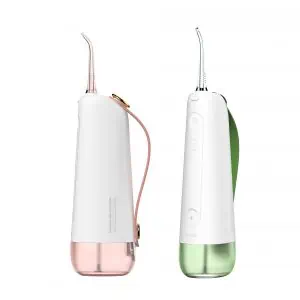Flossing. It’s something you know you should do, but how often do you actually get around to it? We get it; it’s fiddly and annoying and you often end up cutting off circulation to one or more fingers. Perhaps – if you’re honest – you’re not really sure how to floss properly anyway.
If this is a habit you’ve fallen behind on, you’re certainly not alone. Only 31% of British adults use dental floss daily.
But it’s actually an important part of your daily oral hygiene routine, so it’s great that you’re here to find out more about the right technique.
And if you’re not a fan of traditional dental floss, don’t worry. There is a variety of products that use different technologies to make the job much easier – as well as some eco-friendly options for those worried about plastic waste.
Keep reading to find out which products would be best for you.
Best Products for a Better Floss | ||
Oral-B Satin Tape 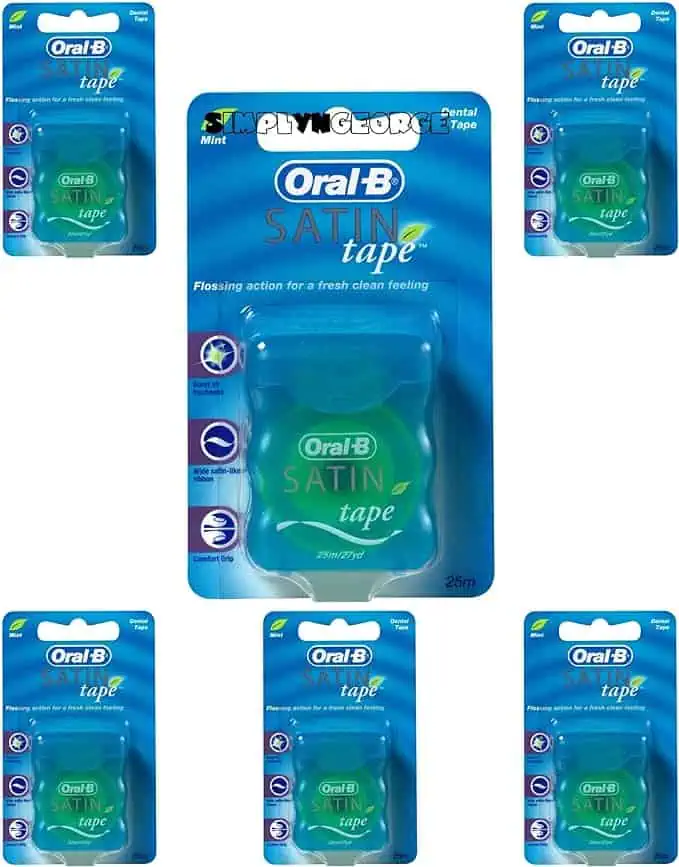 |
| |
Oclean W10 water flosser |
| |
Waterpik WP-660UK Ultra Professional Water Flosser  |
| |
Philips Sonicare AirFloss 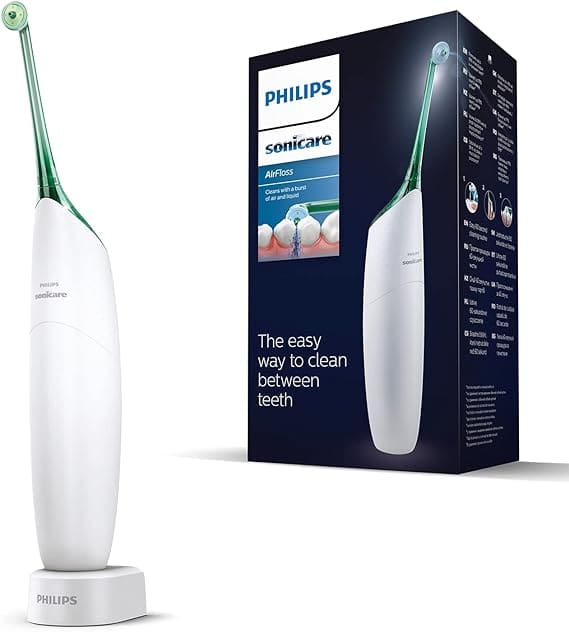 |
| |
In This Article
Why does flossing teeth matter?
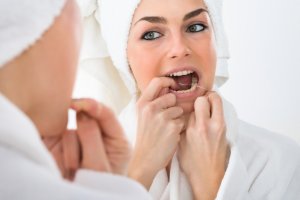
Small food particles can easily get lodged in the gaps between your teeth and below the gum line.
When you brush your teeth, you scrub bacteria, plaque and food particles off the chewing surfaces and visible sides of your teeth. But a regular toothbrush can’t reach the tight spaces between your teeth and under your gums. This is why you need to do some kind of interdental (between-teeth) cleaning, too.
If you don’t thoroughly clean plaque from your teeth, it hardens over time to form a substance called tartar. This thick deposit can’t be removed by brushing or flossing teeth; only dentists can dislodge it with their dental scaling tools (and the process isn’t exactly pleasant).
Plaque and tartar build-up on your teeth creates a breeding ground for bacteria, which then start attacking your tooth enamel. It also makes your breath smell. If plaque develops in pockets between the teeth and gums it usually leads to gum disease (gingivitis). This condition eventually causes teeth to become loose and even fall out if it’s not treated.
Brushing your teeth properly twice a day is essential for keeping your teeth and gums healthy, and some of the best electric toothbrushes use a pulsing motion to help clean between teeth. But they are still not a complete replacement for flossing.
If this isn’t good enough motivation for you, consider this: looking after your teeth well now should mean you need less dental work in the future. The cost of fillings, root canals, extractions, crowns, implants, etc. can easily add up, so you could say that flossing now will save you money on your future dental bills.
Summary of the benefits of flossing
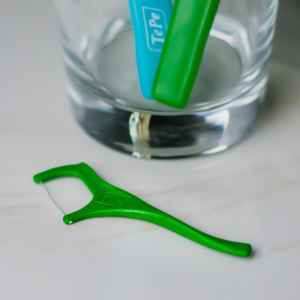
To quickly recap, cleaning between teeth means:
- Cleaner teeth and gums
- Fresher breath
- Less need for painful tartar removal at the dentist
- Fewer cavities (and subsequent fillings)
- Less risk of developing gum disease
- Improved oral health so fewer complications later in life
- Less money spent on dental work!
So, although you may not enjoy daily flossing, you’re investing in your future oral health by making the effort to do it.
A water flosser (oral irrigator) can make flossing much quicker and easier. It sends a high-powered water jet between your teeth to clean where brushing can’t.
Waterpik makes a range of high-quality oral irrigators, but for the best performance and full control when you floss with braces, we suggest the WP-660UK countertop model with 10-speed settings.

It will make oral care with braces much quicker and easier, increasing the chances that you (or your child) keep up a good routine!
How to floss your teeth
So, now you’re convinced of the benefits, what is the correct way to clean between your teeth? There are several factors to consider here: when, how often and how to floss properly?
How often should you floss?
Both the NHS and the Oral Health Foundation recommend cleaning between teeth at least once a day. Your dentist probably gives you the same advice every time you visit.
Children can start flossing when they are around 12, but they will need adult help and supervision at first.
It’s recommended that you floss once a day to clean between teeth. Whether you floss in the morning, evening or midday is a matter of personal preference. Flossing before bedtime ensures the mouth is clean while sleeping. But, the goal is a daily flossing to ensure all sides of your tooth are cleaned.
Toothbrushing can’t reach in between teeth and up into the gumline like flossing can. Plaque bacteria, if not removed, can cause inflammation of your gum tissue, gingivitis, or gum disease. Irritated tissue is characterized by red, swollen, and bleeding gums. It doesn’t take long to floss, but that little act can result in big benefits for oral health.
Dr. Travis R. Willey
Should you floss before or after brushing?
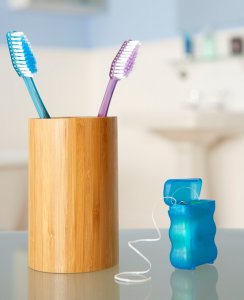
There are mixed theories on whether your should floss first or brush first.
The advice from the NHS and the Oral Health Foundation is to floss before you brush. The logic behind this is that it helps dislodge any food and plaque on and between teeth so the fluoride in your toothpaste gets better access to the surface of the tooth.
“Brushing alone only cleans three of the five surfaces of our teeth, so cleaning between them before we pick up our toothbrush is hugely beneficial. It helps to prevent gum disease by removing plaque from areas the toothbrush alone cannot reach,” said Oral Health Foundation Chief Executive Dr Nigel Carter following the release of a study which showed the benefits of flossing teeth first.
On the other hand, there is a case for brushing first because this removes most of the plaque on your teeth and coats them with fluoride. Then, when you floss, this helps work the fluoride between your teeth.
Some experts say it doesn’t really matter – as long as you incorporate both elements into your daily hygiene routine. You might want to experiment and see which way around works best for you. The important thing is that you get into the habit of cleaning every surface of every tooth, every day.
We have a separate article that addresses the question of whether you should floss before or after brushing if you want to learn more.
How do you floss? The best teeth flossing technique
It’s easiest to see how to floss teeth by watching someone do it. Work your way methodically around your mouth and follow the same pattern every day. This will make it less likely that you miss a tooth. Here is a short video explaining how to use dental floss correctly:
To summarise the steps involved:
- Choose a floss that suits you (waxed or unwaxed; flavoured or unflavoured; single or multi strand).
- Break off about 45cm (18in).
- Wind some around your index or middle finger on each hand, leaving about 5cm exposed.
- Pull it tight and use your thumbs to guide it into place between your teeth.
- Be careful not to force it or snap it onto your gums.
- Curve the floss around one tooth and gently push it as far as it will go, past the gum line.
- Move it up and down along the side of the tooth 8-10 times (not side to side).
- Repeat for the tooth on the other side.
- Gently remove the string from that gap and unwind a clean piece to use on the next gap.
- Don’t forget to clean the back of your four rear teeth as these can be difficult to reach with a toothbrush.
- Rinse with water or mouthwash.
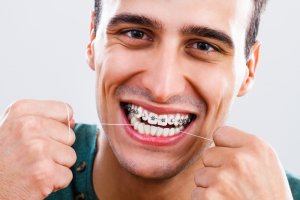
You might notice your gums bleed a little when you first start flossing. This is probably just a sign that you are doing a good job of dislodging plaque, and the bleeding should subside after a few days of doing it. If it continues, it may be that you need to change your technique or use a different product. Speak to your dentist if this is the case.
To see whether you’re flossing properly and removing all the plaque between your teeth, try using a plaque discloser. These tablets and solutions dye plaque to reveal any that’s been missed when you brush and floss.
We’ll explain how to use other flossing tools and products in the section below.
Cleaning around braces and bridges
Cleaning your teeth gets more complicated if you are wearing any style of fixed braces. You can’t slide anything all the way down the gap between your teeth since the archwire is in the way. Dental bridges present a similar problem as the teeth are joined together.
Check our article on how to floss correctly with braces for some tips, techniques and products to make the process a little less fiddly and time-consuming. You might want to invest in a water flosser, but speak to your orthodontist to see what he or she recommends.
Products for better flossing
Now let’s take a look at the best dental floss and other products available to help you make flossing your teeth a part of your daily routine. At the bottom you’ll find a table to quickly compare the main features of each of these.
Dental floss
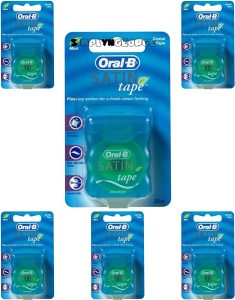
If you think that all dental floss is the same, think again. This thin string is available with a variety of different features to suit different people’s preferences.
For example, you may buy it waxed or unwaxed and with the option of different flavours. It can come as monofilament (single-strand) or multifilament (multi-strand). Monofilament floss doesn’t fray and a wax-coated variety, like Oral-B Satin Floss, should slide between teeth more easily. These features increase the cost, but only slightly.
Dental tape
If you have crowded teeth with particularly small gaps then you may get on better with a dental tape. This is exactly as it sounds; a very thin, flat tape which serves the same purpose as string floss.
Dental tape can slide more easily into very tight gaps, so if you struggle with dental floss getting stuck between your teeth, you could give tape a try instead. Oral-B Satin Tape has a fresh minty taste and is highly rated by people who find floss snags on their teeth.
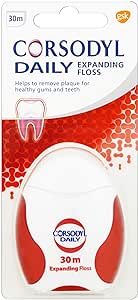
“Fantastic dental tape. Much better than floss, even if you’ve got teeth that are very close together the tape slides easily between them. I find it takes about half the time to floss using this tape than with regular floss. Outstanding value too,” says one enthusiastic reviewer.
Expanding dental floss
If you find normal dental floss or tape too thin or smooth, you might get along better with unwaxed expanding dental floss. This is made from compressed fibres which expand between the teeth. It could be the best floss for teeth which are tightly packed at the crown but have larger gaps at the gumline.
One highly rated floss of this type is Corsodyl Daily Expanding Floss. Some users prefer the more abrasive feeling that it provides in contrast to waxed floss, although it is still gentle on gums. It also contains fluoride which helps protect teeth.
Dental floss sticks/picks
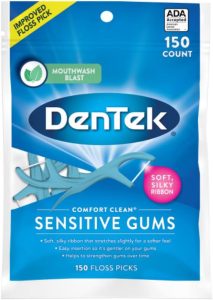
If you struggle with the dexterity required to use string wound around your fingers, you may try using a dental floss stick, also known as a ‘pick’ or ‘wand’. These disposable items consist of a short piece of floss suspended between two plastic prongs on a handle. Often the handle is shaped into a point which can be used as a toothpick.
DenTek dental floss sticks are one popular brand, although you might want to try a few to find a shape and design that fits easily in your mouth. These DenTek Comfort Clean Floss Picks have a silky floss with a cool mint taste and are fluoride coated for extra tooth protection.
While they certainly make it easier to reach and floss back teeth, they don’t offer the same range of motion as loose string floss and they may miss the area below the gum line. They’re also not the best option if you’re conscious of the amount of plastic you throw away. You might find this device more hygienic though, as you aren’t touching the bacteria-covered string during use.
Biodegradable floss
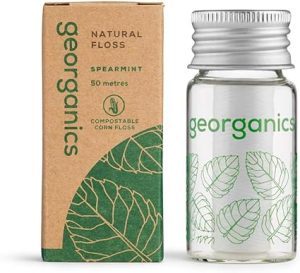
If you’re looking for an eco-friendly floss, you’ll be pleased to hear there are several options available in the UK. Our guide to biodegradable dental floss explains these in more detail, but one of the most popular is Georganics natural silk floss which comes in spearmint cardamom and orange flavours.
Natural floss is sometimes not quite as strong as the conventional plastic options, and it may not feel quite as thin and smooth. This is more likely to be a problem if your teeth are crooked or very tightly spaced. Still, if you’d prefer not to be throwing hundreds of metres of plastic floss into landfill every year, these eco options are definitely worth a try.
Interdental (interproximal) brushes
Another effective flossing tool for removing plaque from between teeth is interdental brushes. These very small brushes are designed to fit in the spaces between teeth and dislodge any plaque or food particles stuck there.
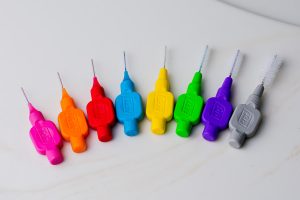
Interdental brushes can be less fiddly than dental floss, and you can read more about the different brands, sizes and types of interdental brush in our full guide. One potential downside is the amount of plastic waste they produce, since these little brushes only last 1-2 weeks at most with regular use. However, there are various eco-friendly options which we cover in our guide as well.
Oral irrigators (water jets)
For a more technological approach to cleaning between your teeth and under your gums, you could consider a water or air flosser. These hand-held devices, also known as oral irrigators, deliver a pressurised burst of air and/or water between two teeth. For some people, they are the easiest way to floss, especially for hard-to-reach back teeth.
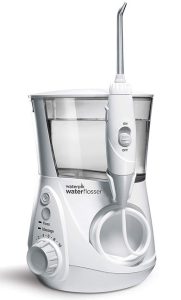
Two of the most popular models in this market are the Waterpik WP-660UK, the Philips Sonicare AirFloss, and the Oral-B water flosser. The AirFloss combines air and water in short bursts to “take the hassle out of flossing”. It uses only about a teaspoon of water per session, compared to the Waterpik which uses a lot more.
Or, for a more affordable water flosser with similar features to these well-known brands, read our review on the Oclean W10 water flosser.
And, we have a separate guide to the best Waterpik flossers in the UK with more information about the different models available. They are the leading brand and come with a 2-year guarantee, so are a good investment if you’re tired of string floss.
There is some doubt among dentists as to whether water jets are as effective as traditional string floss, which physically scrapes plaque from teeth. And of course, they cost more up-front.
However, if you have trouble using regular techniques then a water flosser may be the next best thing. They also carry comparatively little risk of damage to gum tissue and are much easier to use if you’re wearing braces. If you’re considering investing in one of these, check out our guide to the best water flossers in the UK.
You can also read about the 5 benefits of water flossing.
Product summary
Dental floss/tape | Dental floss sticks/picks | Oclean W10 water flosser | Philips Sonicare AirFloss Pro | Waterpik WP-660UK Ultra | |
Cleaning method | Scrapes plaque from teeth | Scrapes plaque from teeth | Steady or pulsing water jet with 5 modes | Microburst technology (pressurised air and water) | Steady or pulsing water jet with 10 pressure settings |
Features | May be flavoured or waxed for smoother movement | Plastic handle; may be waxed or flavoured | Erganomic design with a timer; fast-charging and long-lasting battery | Angled nozzle; cordless; guidance tip for proper positioning | Pacer and timer; separate water reservoir |
Pros | Cheap; most effective | Easy to reach back of mouth; hygienic | Easy to use with braces; gentle on gums, easy to hold | Easy to use with braces; gentle on gums; fits Sonicare toothbrush chargers | Easy to use with braces; gentle on gums |
Cons | Fiddly/difficult to use; may damage gums if not used properly | Disposable plastic; doesn't achieve full range of motion; may damage gums | Moderate cost; may not be as effective as normal flossing; lots of water can be messy | High cost; may not be as effective as normal flossing | High cost; may not be as effective as normal flossing; lots of water can be messy |
Cost |
Keeping your teeth healthy
Cleaning your teeth well is just one part of maintaining good oral health. In addition, you should:
- Use a fluoride toothpaste
- Limit your consumption of sugary foods and drinks, and avoid snacking on them throughout the day
- Get regular dental checkups and cleanings
If you have any concerns about the state of your teeth, don’t put off going to the dentist. The longer you leave it, the worse the problem is likely to get. You’ll feel much better once any issues have been treated!






